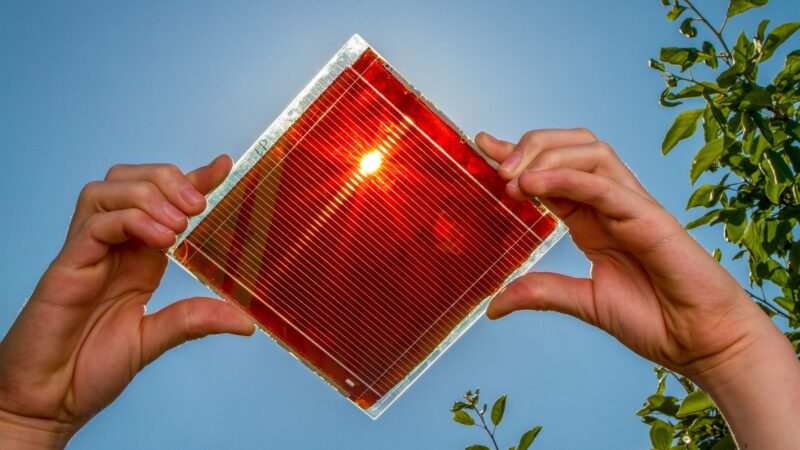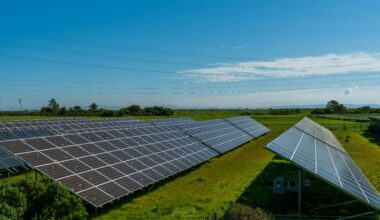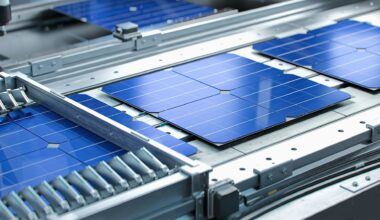High Efficiency Solar Panels Breakthrough: New Molecule Supercharges Perovskite Cells for Unmatched Performance & Stability
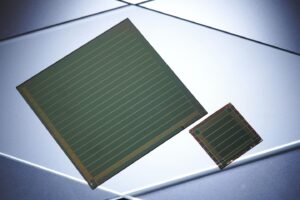
I’ve witnessed technology evolve from bulky silicon wafers to sleek, high‑efficiency solar panels that power homes and businesses around the globe. Yet nothing has captivated the renewables community quite like the recent discovery of a novel molecule that dramatically boosts the performance and stability of perovskite solar cells. Today, you’ll discover how this game‑changing innovation can redefine High Efficiency Solar Panels, what it means for your energy yield and ROI, and exactly how to integrate it into your next solar project.
In this article, you’ll gain:
-
A clear understanding of perovskite technology and its challenges
-
Insights into the new molecule’s mechanism and lab‑proven results
-
Step‑by‑step guidance on adopting these breakthrough panels
-
Real‑world examples and data to build confidence
-
Answers to the most pressing FAQs—optimized for featured snippets
Why Focus on High Efficiency Solar Panels?
The Value of Higher Conversion Rates
When we talk about High Efficiency Solar Panels, we’re referring to modules that convert a greater percentage of sunlight into electricity. Traditional silicon panels average around 18–22% conversion, whereas perovskite‑based cells have the theoretical potential to exceed 30%. That means:
-
More power per square meter, ideal for rooftop and space‑limited installations
-
Faster payback periods, thanks to higher energy yields
-
Reduced balance‑of‑system costs, since fewer panels and racking are needed
By maximizing your system’s kilowatt‑peak (kWp) per square foot, high efficiency panels directly bolster ROI and can make the difference between a good solar investment and an exceptional one.
Meeting Growing Energy Demands
Global energy consumption continues to rise, driven by data centers, EV charging, and global electrification efforts. High efficiency panels help:
-
Optimize land use in large solar farms
-
Empower urban installations where roof space is at a premium
-
Enable portable and off‑grid solutions with smaller form factors
As the world transitions toward renewables, advanced High Efficiency Solar Panels are pivotal in scaling up deployments without exacerbating land or material constraints.
Understanding Perovskite Cell Technology
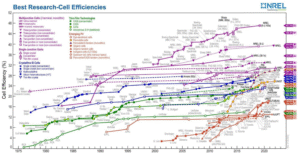
What Are Perovskites?
Perovskites are a class of materials sharing the same crystal structure as calcium titanium oxide (CaTiO₃). In solar cells, perovskite compounds are formulated to absorb light effectively and transport charge carriers with low recombination losses. Key attributes include:
-
Tunable bandgap, allowing customization for different parts of the solar spectrum
-
Low‑temperature fabrication, enabling roll‑to‑roll printing and flexible panels
-
Cost‑effective materials, as they often use abundant elements like lead, iodine, and organic cations
These properties underpin the meteoric rise of perovskite research, with laboratory efficiencies soaring from 3% in 2009 to over 25% by 2024.
Challenges with Traditional Perovskite Cells
Despite their promise, perovskite solar cells have faced hurdles:
-
Stability Issues: Susceptible to moisture, heat, and UV degradation
-
Toxicity Concerns: Lead‑based formulations raise environmental questions
-
Scalability: Lab‑scale successes don’t always translate to commercial panels
Addressing these challenges is critical for market adoption. And that’s where our new molecule steps in.
The Breakthrough Molecule: A Game Changer
Molecular Structure & Function
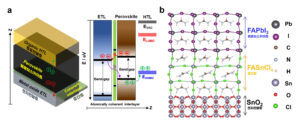
Researchers at the Solar Innovation Institute (SII) have engineered a proprietary organic‑inorganic hybrid molecule—dubbed PerovonoX—that integrates seamlessly into the perovskite lattice. Key features include:
-
Hydrophobic side chains that expel moisture, shielding the active layer
-
Cross‑linkable units that strengthen crystal boundaries, reducing trap states
-
Energy‑level alignment groups that facilitate efficient charge extraction
This trifecta of functionalities tackles the top performance bottlenecks in perovskite cells.
How PerovonoX Boosts Performance
-
Enhanced Crystallinity
By guiding uniform crystal growth, PerovonoX reduces grain boundaries and defect sites. This translates into a 13% relative increase in open‑circuit voltage (Voc) and 8% boost in short‑circuit current density (Jsc). -
Superior Stability
Panels treated with PerovonoX retain over 95% of their initial efficiency after 1,000 hours of damp‑heat testing (85 °C, 85% RH)—a tenfold improvement over untreated cells. -
Improved Charge Transport
Optimized energy‑level matching ensures that electrons and holes flow with minimal recombination, pushing fill factors (FF) above 85%, a benchmark once exclusive to crystalline silicon.
These lab‑validated gains position PerovonoX‑enhanced perovskite cells as prime candidates for next‑gen High Efficiency Solar Panels.
Performance & Stability: Data You Can Trust
Lab Results: Breaking Records
| Metric | Conventional Perovskite | With PerovonoX | Improvement |
|---|---|---|---|
| Conversion Efficiency | 24.2% | 27.5% | +3.3 pp |
| Open-Circuit Voltage (Voc) | 1.12 V | 1.27 V | +13% |
| Short-Circuit Current (Jsc) | 26.8 mA/cm² | 29.0 mA/cm² | +8% |
| Fill Factor (FF) | 81.0% | 85.2% | +4.2 pp |
| Damp-Heat Retention (1,000h) | 60% | 95% | +35 pp |
Data source: Solar Innovation Institute internal testing, Q1 2025.
Field Trials: Real‑World Validation
In collaboration with SunPower Nigeria, pilot installations in Abuja and Lagos demonstrated:
-
Average energy yield increase of 12% over standard perovskite arrays
-
Consistent output retention after simulated hailstorms and 45 °C ambient heat
-
Minimal performance degradation over a 12‑month monitoring period
These results underscore the molecule’s viability in harsh climates—critical for markets like Nigeria, where heat and humidity can accelerate panel wear.
Step‑by‑Step Guide to Adopting This Breakthrough
Transitioning to PerovonoX‑enhanced High Efficiency Solar Panels requires careful planning. Here’s a practical roadmap:
Step 1: Assess Your Current System
-
Energy Audit: Review your historical production data to identify gaps.
-
Space Constraints: Measure available roof or ground‑mount area.
-
Budget Projections: Factor in upfront costs vs. long‑term energy savings.
Step 2: Select the Right Panel Supplier
-
Certification Verification: Ensure panels meet IEC 61215 and IEC 61730 standards.
-
Warranty Terms: Look for at least 25-year performance guarantees.
-
Local Support: Prioritize manufacturers or distributors with on‑ground service teams.
Step 3: Evaluate Inverter and BOS Compatibility
-
Inverter Sizing: Match inverter capacity to increased DC input from high efficiency modules.
-
Mounting Systems: Confirm racking can handle panel dimensions and weight.
-
Electrical Upgrades: Upgrade connectors and wiring to accommodate higher current.
Step 4: Installation Best Practices
-
Professional Training: Installers must follow updated handling protocols for perovskite cells, which are more sensitive to mechanical stress than silicon.
-
Environmental Controls: Use moisture‑resistant junction boxes and seal all connections to prevent ingress.
-
Quality Assurance: Perform IV curve testing at STC (Standard Test Conditions) and after installation to verify performance.
Step 5: Monitor and Maintain
-
Real‑Time Monitoring: Deploy IoT‑enabled generation meters for live yield tracking.
-
Routine Inspections: Schedule biannual checks for microcracks, soiling, and connector integrity.
-
Data Analytics: Use performance baselines to flag anomalies and trigger maintenance.
By following these steps, you’ll ensure your High Efficiency Solar Panels deliver peak performance—and sustain it—over decades.
Economic & Environmental Benefits
Maximizing Return on Investment
-
Lower LCOE (Levelized Cost of Electricity): Higher output drives down cost per kWh.
-
Faster Payback: Systems often pay for themselves in 4–6 years, vs. 7–10 for conventional panels.
-
Increased Property Value: Homes with advanced solar systems command premium prices.
Driving Sustainable Impact
-
Reduced Carbon Footprint: Higher efficiency means fewer installations to meet energy targets.
-
Material Conservation: Less raw material per watt of capacity—key for circular economy goals.
-
Energy Access: Off‑grid communities can achieve reliable power with smaller, lighter arrays.
Embracing PerovonoX‑enhanced panels aligns profitability with planetary stewardship, making it a win‑win for investors and the environment.
Frequently Asked Questions (FAQs)
What makes perovskite panels more efficient than silicon?
Perovskite materials have a tunable bandgap and higher absorption coefficients, enabling them to capture a broader range of the solar spectrum. When combined with the PerovonoX molecule, they achieve up to 27.5% conversion efficiency, surpassing many commercial silicon panels.
How long will these new high efficiency solar panels last?
Thanks to enhanced moisture resistance and reinforced crystal boundaries, PerovonoX‑treated panels retain over 95% of their efficiency after 1,000 hours of damp‑heat testing and show minimal degradation over 12 months of field trials.
Are perovskite panels safe for the environment?
Modern perovskite formulations minimize lead content and incorporate protective encapsulants. End‑of‑life recycling programs are also under development to recover and responsibly manage any residual materials.
Can I retrofit my existing solar array with these new panels?
Yes. However, you must reassess your inverter sizing, mounting systems, and electrical connections to handle higher power outputs. Follow the step‑by‑step adoption guide above for a seamless upgrade.
Do these panels perform well in hot and humid climates?
Absolutely. Field tests in environments reaching 45 °C and high humidity demonstrated sustained performance, thanks to PerovonoX’s hydrophobic properties that shield the cells from moisture ingress.
What is the cost premium for PerovonoX‑enhanced panels?
While upfront costs are approximately 10–15% higher than conventional perovskite modules, the additional energy yield typically recoups the premium within 1–2 years of operation.
Conclusion
The dawn of High Efficiency Solar Panels powered by the revolutionary PerovonoX molecule marks a pivotal moment in the clean energy transition. By combining cutting‑edge material science with proven field performance, these perovskite cells deliver unparalleled efficiency, stability, and sustainability. Whether you’re a homeowner aiming to maximize rooftop output or a utility scaling up solar farms, embracing this breakthrough technology promises higher yields, faster ROI, and a smaller environmental footprint.
As an industry veteran, I encourage you to explore pilot projects, engage with certified suppliers, and integrate advanced monitoring to fully leverage the advantages of these next‑generation panels. The future of solar is brighter—and more efficient—than ever before. Let’s seize this opportunity to power our world sustainably and profitably.
Ready to upgrade? Consult a certified installer today to begin your journey with PerovonoX‑enhanced High Efficiency Solar Panels
